
Velocette is a line of motorcycles made by Veloce Ltd, in Hall Green, Birmingham, England. One of several motorcycle manufacturers in Birmingham, Velocette was a small, family-owned firm, selling almost as many hand-built motorcycles during its lifetime, as the mass-produced machines of the giant BSA and Norton concerns. Renowned for the quality of its products, the company was "always in the picture" in international motorcycle racing, from the mid-1920s through the 1950s, culminating in two World Championship titles and its legendary and still-unbeaten 24 hours at over 100 mph (161 km/h) record. Veloce, while small, was a great technical innovator and many of its patented designs are commonplace on motorcycles today, including the positive-stop foot shift and swinging arm rear suspension with hydraulic dampers. The business suffered a gradual commercial decline during the late 1960s, eventually closing in February 1971.
Royal Enfield was a brand name under which The Enfield Cycle Company Limited of Redditch, Worcestershire sold motorcycles, bicycles, lawnmowers and stationary engines which they had manufactured. Enfield Cycle Company also used the brand name Enfield without Royal.

Matchless is one of the oldest marques of British motorcycles, manufactured in Plumstead, London, between 1899 and 1966. A wide range of models was produced under the Matchless name, ranging from small two-strokes to 750 cc four-stroke twins. Matchless had a long history of racing success; a Matchless ridden by Charlie Collier won the first single-cylinder race in the first Isle of Man TT in 1907.

Geoff Monty was an English professional motorcycle racer, constructor, rider-sponsor and retail dealer, initially based in Kingston on Thames and later – under the name Monty and Ward – Twickenham areas, near London, with a move to Edenbridge, Kent by 1968.

AMAL was a British engineering company servicing the motorcycle and other light-engineering motor industries between 1927 and 1993 based in Birmingham, England.
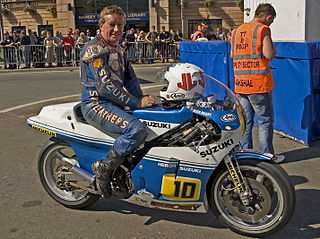
Mick Grant is an English former professional motorcycle road racer and TT rider. A works-supported rider for Norton, Kawasaki, Honda and Suzuki, he is a seven-time winner of the Isle of Man TT motorcycle race on various makes, including 'Slippery Sam', a three-cylinder Triumph Trident. The son of a coal miner, the soft-spoken, down-to-earth Yorkshireman from Wakefield, was a sharp contrast to the brash, playboy image presented by Londoner Barry Sheene during the 1970s.

Thomas Edward Phillis was an Australian professional Grand Prix motorcycle road racer. He won the 1961 125cc motorcycle road racing World Championship and was the first person to lap the TT mountain circuit at over 100 mph on a pushrod engined motorcycle. He was also the first person to win a World Championship motorcycle race on a Japanese machine.

Douglas Lionel Hele was a pioneering British motorcycle engineer with Triumph and other firms: BSA, Douglas and Norton. He was born in Birmingham in 1919 and died in Hagley, Worcestershire on 2 November 2001.

Peter Williams was a British former professional motorcycle racer. He competed in Grand Prix motorcycle road racing from 1966 to 1973. He also competed at many levels on home short-circuit races. He raced many times on the Isle of Man TT course from 1966 to 1973. His father was Jack Williams who ran the Associated Motor Cycles (AMC) race department. Williams trained in mechanical engineering and introduced via racing alloy wheels, an innovation which is commonplace on today's road bikes, and was also an early pioneer of solo-motorcycle disc brakes.

The Triumph Thruxton is a series of British motorcycles with parallel-twin engines and sports styling. The name Thruxton was first applied to a handbuilt machine for endurance racing in the mid 1960s, and later revived in the 2000s.

Philip Edward Irving MBE, CEng., FIMechE., MSAE., (1903–1992) was an Australian engineer and author, most famous for the Repco-Brabham Formula One and Vincent motorcycle engines. He also worked at Velocette motorcycles, twice, and drew the engine of the 1960 EMC 125cc racer.
The Thruxton 500 was a motorcycle endurance race for production based road machines, covering 500 miles and ridden by a team of two riders per machine. The first event was a 9-hour race which took place in 1955, organized by the Southampton and District Motorcycle Club (SDMCC) at the Thruxton Circuit near Andover in Hampshire. Two more 9-hour races followed in 1956 and 1957.

The Velocette Venom was a 499 cc single-cylinder four-stroke British motorcycle made by Velocette at Hall Green in Birmingham. A total of 5,721 machines were produced between 1955 and 1970.
The Velocette MSS is a motorcycle made by Velocette. It was fast, reliable and economical but could not compete against a new range of British twin-cylinder motorcycles. Production ended in 1968.

The featherbed frame was a motorcycle frame developed by the British Norton motorcycle company to improve the performance of their racing motorcycles around the twisting and demanding Isle of Man TT course in 1950. It was considered revolutionary at the time, and the best handling frame that a racer could have. Later adopted for Norton production motorcycles, it was also widely used by builders of custom hybrids such as the Triton, becoming legendary and remaining influential to this day.

The BSA Lightning was a British BSA 650 cc-class motorcycle made in Birmingham between 1965 and 1972.
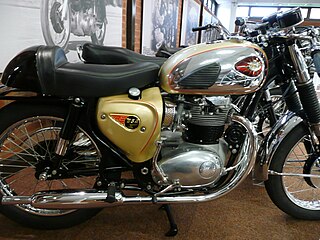
The BSA Lightning Clubman was a 650cc British motorcycle made by BSA at their factory in Birmingham between 1964 and 1965. Finished in gold and black the Lightning Clubman is now a highly sought after classic motorcycle. Due to the very limited production numbers replicas are created by enthusiasts from the BSA Lightning.
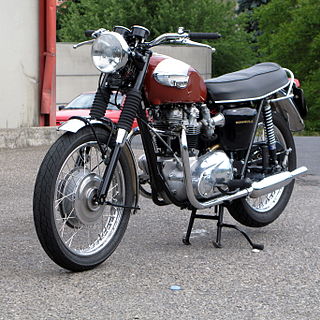
The Triumph Bonneville T120 is a motorcycle originally made by Triumph Engineering from 1959 to 1975. It was the first model of the Bonneville series, which was continued by Triumph Motorcycles Ltd. The T120 was discontinued in favour of the larger 750 cc T140 in the early 1970s.
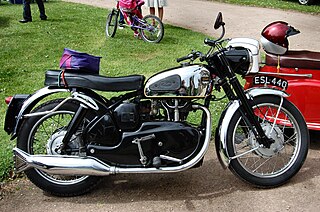
The Velocette Viper is a British motorcycle made by Velocette between 1955 and 1968. Built using traditional methods and materials, it struggled to compete against more modern machines, so from 1960 the designers added new glass fibre enclosure panels, making the Viper one of the first enclosed production motorcycles.
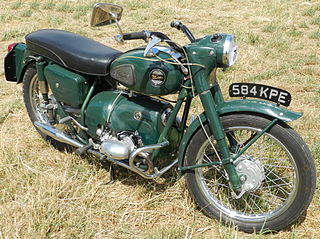
The Velocette Valiant was a British motorcycle produced by Velocette from 1957 to 1963. Launched at the 1956 Earl's Court Motorcycle Show, the Valiant had a 192 cc (11.7cu in) flat-twin engine but was expensive and criticized for its underpowered engine.


















